
By Ronni Sandroff | Oct. 2017 | Health Central
When I inquired about plans for hurricane season, the director at my mother’s Florida assisted living center was unconcerned. “Don’t worry about it,” he said. “We’ve been through several big ones and never had any damage or lost power.” In hindsight, I should have countered with “past performance is no guarantee of future results” and asked a lot more questions.
Given recent horrific incidents, including the death of eight residents after Hurricane Irma knocked out power to a Florida nursing home in September 2017, a top concern for anyone choosing or re-evaluating a facility should be emergency preparedness. A blithe “don’t worry about it” may be a warning sign that the director is not comfortable sharing key details.
Ask about generator capacity
While most facilities have some emergency preparedness, “ask whether their plan was developed in coordination with, and/or approved by, someone with expertise in this area,” advises Lori Smetanka, executive director of the National Consumer Voice for Quality Long-Term Care.
Probe whether the facility has a stockpile of supplies and medications on hand and adequate generator capacity to run all systems, including air conditioning, heat, medical machines, and elevators if there’s a loss of power. Other key issues, Smetanka says, include:
- How staff members prepare for and respond to emergencies.
- How often the facility participates in disaster planning drills, not just internally, but as part of a community effort.
- How the facility makes, sure enough, staff members are present to respond to an emergency situation.
Pose these questions
Disaster response plans are only as good as the people implementing them. In some nursing home incidents “there seems to be a failure to sound the alarm,” says Peggy Flannigan, associate professor of nursing at Bradley University in Washington, D.C. “I have to wonder if the administrator was in over his or her head and just didn’t know where to turn.”
So perhaps the most important thing to do is consider the competence and caring of the facility’s leadership. Can they clearly answer such questions as:
- What if the staff is unable to make it into work?
- Will extra staff be staying in the facility if there’s a flood or hurricane warning?
- Who will be in charge?
- Who will be in touch with residents’ families to let them know what’s going on?
Do your homework
Ronni Sandroff, an award-winning writer and former health editorial director at Consumer Reports, covers mind, behavior, and culture from Southern Florida.

If your plans for Saturday include a walk in the park and vacuuming your house, which will you do first? Many factors, like the weather forecast, or the time your in-laws are arriving, could go into that choice. But it might surprise you to learn that such an everyday decision strongly and predictably depends on what kind of a mood you’re in at the moment.
In an extensive study led by Harvard Medical School researcher Maxime Taquet, Ph.D., more than 28,000 people were contacted via a smartphone app at random times throughout the day for an average of 27 days.
They were asked about their mood and the activity they were doing. The results, published in the Proceedings of the National Academy of Sciences in August 2016, revealed that a person’s current mood would accurately predict what he or she will be doing and feeling in the next few hours.
While previous work in this area assumed that pleasure-seeking was the strongest motivator of people’s choices, the study’s results challenged that idea.
It found that when people feel bad, they seek mood-boosting activities, and when they feel good, they choose necessary but less pleasant tasks. Current mood can double or triple the likelihood that you later engage in certain types of activities, according to the study authors.
Cut yourself some slack
Taquet says he has learned some life lessons from his study. “When I’m rushing for a deadline and feel the urge to go out, see a friend, or do some exercise, I used to feel guilty, thinking that I was merely procrastinating or slacking off,” he says. “Now I know that this may be necessary to recharge my happiness battery so that I can carry on with my longer-term goal. This is an adaptive behavior that may prove very useful for us humans.”
When we need some cheering up, we move toward mood-enhancing activities, such as sports, chatting, going out for a walk, or for a drink. When we’re already in a good mood, we gravitate to less pleasant activities, such as working, shopping, cooking, and cleaning, perhaps thinking that our mood will tolerate them.
Coax yourself into productivity
When mood cannot influence your choice of activity (for example, you have to go to work), it can still affect both your productivity and attitude about the work. A small study published in The Academy of Management Journal in 2011 tracked how waking up on the wrong side of the bed affected the work day.
Promo block
Researchers Nancy Rothbard and Steffanie L. Wilk tracked the moods and performance of customer service representatives at an insurance company call center. They found that those who started the day in a good mood provided better quality service and tended to feel more positively about the customers they talked to, describing them as calm, cheerful, and friendly.
But the reps who started out in a bad mood more often described their customers as rude, frustrating, or insulting.
It may not be possible to check your mood at the door when you start your day, but there are steps you can take to shrug off the lingering effects of a frantic morning with your family or a frustrating commute. Rothbard suggests testing out such techniques as listening to music, stopping for coffee, giving yourself a pep talk, and taking a deep breath and getting ready for a new situation.
Leverage your good moods
If you’re feeling psyched because you just exercised, enjoyed an affectionate phone call, or woke up on the right side of the bed, you can view your good mood as a lever toward longer-term goals. This may be just the time to tackle tasks you’ve been avoiding, and, yes, that might depress your mood a bit, but they’ll get done‑and what a relief to have them off your to-do list.
“The idea that we sacrifice our instant pleasures certainly sounds counterintuitive,” Taquet says. “But unpleasant yet necessary tasks need to be done at some point, and this is important for our longer-term welfare. What our data and analyses showed was that people, in general, tend to do those things when they feel good.”
So if you’re in a good mood, you’re likely to tackle vacuuming the house before you go to the park. And if you’re in a snit, you’re more likely to go to the park first, in the perhaps unconscious hope of elevating your mood enough to tolerate the vacuuming.

If you’ve recently left the workplace or moved out of state, you may be feeling a little isolated. But don’t despair. New opportunities can still abound, and cultivating new friends can be good for your mental health, too.
When Stanford University invited retired people to come to campus to take classes for a year, the 30 people in that group bonded tightly, says Laura Carstensen, a professor of psychology and founding director of the Stanford Center on Longevity.
“What surprised them was the very important friendships that these folks were forming with one another,” she says. Like the younger students, the retirees were able to leave their previous lives and professional images behind when they got on campus and enjoyed the freedom of being who they were now.
“Social networks get smaller as people age but, surprisingly, older people are more satisfied with them and often report levels of emotional well-being that are higher than those of younger adults,” Carstensen adds.
It may take extra effort to make those new social bonds, as I discovered after leaving the companionship of the workplace and moving away from my home in the Northeast. Here are several steps that can make the process of forging new friendships a bit easier.
1. Explore the landscape
Some organizations, such as Newcomer’s Clubs and MeetUp, focus on providing get-acquainted opportunities for their members with similar interests.
“Even if you haven’t moved, when you retire or semi-retire, you can act like a newcomer in your own city, and do and join the things you missed out on before,” advises life coach Barbara Beizer of Washington, D.C.
Beizer eventually became a board member of The Transition Network, a national group that focuses on “what’s next?” issues for professional women over 50. Joining my local chapter (and volunteering for two committees) helped me get over my “friendless in Florida” phase.
Volunteer, community, and religious groups, as well as lifelong learning classes, are other places to find people with interests like yours who may also be looking for new friends.
2. Pave your way
Don’t be surprised if you enthusiastically put events on your calendar only to find that when the time comes, you’ve got a tiny stomach ache and a large reluctance to leave the house.
Many of us get a bit anxious—I call it “stage fright”—when we enter new situations. It may help to pave your way beforehand by calling or emailing the organization’s officers, introducing yourself to someone, and saying you plan to attend their next function.
If possible, arrange to drive to the event with someone. Hopefully, you’ll have at least one person to look for when you get there, and that will lead to other introductions.
3. Make the first (and second) move
If you feel a spark when chatting with a new person, or just want to continue the conversation, don’t be shy about asking for an email or phone number. I always try to follow up immediately, so we don’t forget each other and propose meeting for coffee. If you enjoy each other, the next time, each of you can invite another acquaintance or two and broaden the circle.
“Just say yes,” to invitations from new individuals or groups. The more I said yes, the more I was invited (no one likes rejection), and the more often people said yes to me when I proposed my favorite activities.
4. Be alert for social connectors
It’s a good idea to mention to people that you’re looking for more social connections. Just as some people fancy themselves to be matchmakers, others have a special talent for connecting people and the generosity of heart to share friends. I was fortunate to meet such a person, and she introduced me to a number of interesting people.
5. Become a regular
Whether it’s at a committee meeting or a dog park, meeting regularly can deepen a connection. “Seeing each other often develops a kind of affection and shared experience,” Beizer says. “It’s the fastest way to get to know people.”
If you see people regularly at an activity you all enjoy, you’re much more likely to find friendship and the health boost that can come with it.
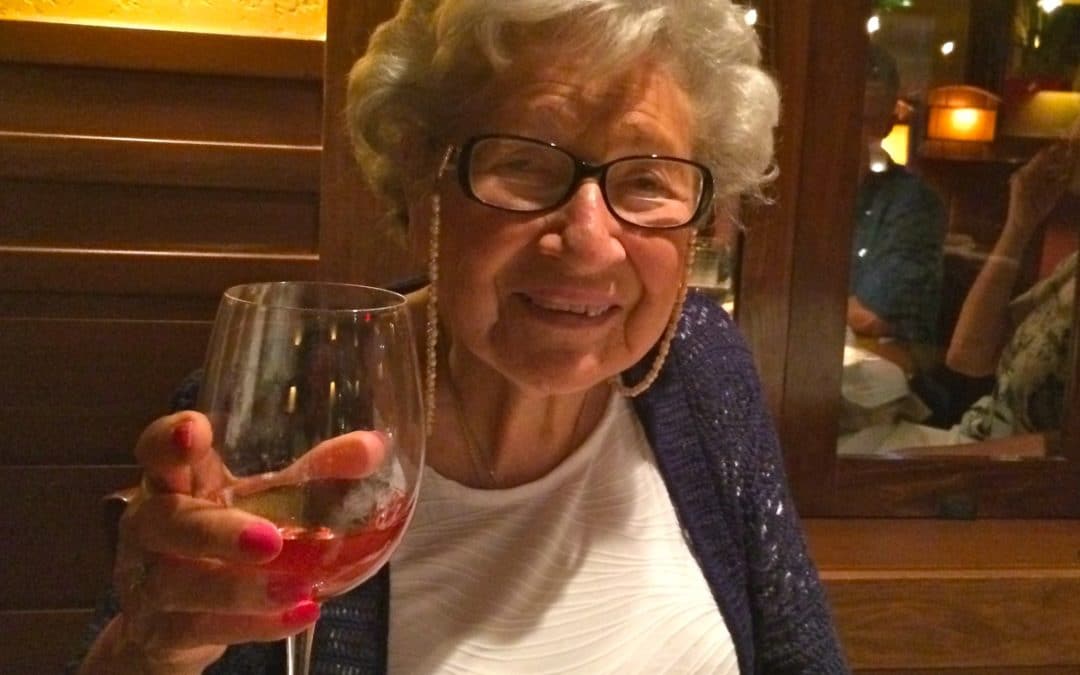
By Ronni Sandroff | October 2017| Health Central
The shift in the relationship that occurs when a parent becomes disabled is an uneasy one for parent and child alike. The crucial issue is often one of control, says Kurt Kazanowski, R.N., owner of Homewatch Caregivers, a Plymouth, Mich., company that provides families with home health aides.
“It’s quite normal for people who were always in charge in their own lives to feel resentful and frustrated as their ability to control things slips away,” he says.
Here are three ways to handle the touchy issue of providing care while leaving some important choices to your loved one.
1. Have a heart-to-heart
It helps if the family has put at least a general plan in place for what to do if a parent becomes disabled. The time for that conversation is no later than their early 70s, Kazanowski advises when parents can clearly express a preference on such issues as power of attorney and where they would prefer to live if they became unable to care for themselves.
Whenever the conversation takes place, start by listening deeply. Sometimes a person with a history of rejecting advice is simply trying to exert some control. Allow the person to talk and complain, so he or she feels supported and understood.
Then try to talk with your parent about how his or her actions and decisions make you feel. As your dynamic changes to caregiver, it can be a good time for healing past wounds, Kazanowski says.
2. Use positive reinforcement
Give your full attention and support when your parent is being reasonable, and share memories and opinions. Allow him or her to make decisions when feasible, such as choosing a restaurant or an outfit. Offer to help your parent find projects to work on, such as painting or knitting, where he or she can exercise creative control.
If your parent seems unusually irritable or out of character, talk to the doctor about whether pain and/or medication reactions are responsible. Perhaps medicines can be changed or dosages reduced. And simple exercises and occupational therapy techniques can help reduce pain symptoms.
3. Pave the way regarding driving
When it’s time to have “the talk” about transportation, try an oblique approach. Instead of suggesting that your parent hand over the car keys, begin by discussing the alternatives, such as today’s availability of van services for the elderly and private cabs through Uber and Lyft for getting to doctor and other appointments.
Then ask your parent how he or she now feels about driving. Sometimes your parent will let you know that he or she is having problems.
Tell your parent what you have observed. It’s best if the older person voluntarily decides not to drive, but it may be necessary to apply tough love to keep your parent and others safe. The Family Caregiver Alliance offers some useful tips on how to handle this situation.
If your parent becomes angry or upset, try to respond with kindness and offer to discuss it. If that doesn’t work, leave the conversation and say you’ll resume it at a better time to avoid responding in anger or getting upset yourself.
Don’t delay hospice
Unfortunately, many people whose parents have chronic conditions like COPD don’t realize they are eligible for hospice care. “Many people tell me, ‘I should have signed up my parent for hospice sooner,’ “ says Kazanowski, who also advises hospice organizations.
Along with medical and nursing management, hospice care offers home health aides, touch therapy, music therapy, spiritual components, and dementia programs. The staff can also help relatives and caregivers relate to the older person and deal with the grieving process.
Ronni Sandroff, an award-winning writer and former health editorial director at Consumer Reports, covers mind, behavior, and culture from Southern Florida.
By Ronni Sandroff | Aug. 2016 | Thetransitionnetwork.org
The explosion of interest came as a surprise to the organizers. It was standing-room-only at the first workshop on senior housing options hosted in 2012 by the San Francisco/Bay Area chapter of The Transition Network. This national network brings together women age 50+ as they experience personal and professional changes.
About 60 women participated in that first half day of presentation on co-living options by Chris Kennedy of Age2Age. They then broke into groups and began to connect and explore their own housing needs and desires. The choices discussed ranged from how to carefully evaluate and contract with a compatible roommate or two, to creating or joining a larger co-living community.
Four years later, TTN-HOME in the SF Bay Area is a robust group that has held more than 30 housing workshops and amassed a listserv of over 500 people who post their needs for housing and available rooms or homes for sale or rent.
Their workshops allow participants to connect with others who have similar housing concerns and to support one another as they explore their options. They’ve also hosted programs on such topics as retirement communities and affordable senior housing.
Age-friendly living
“We have people coming with a range of different needs,” says Arlene Reiff, one of the founders of the TTN-HOME planning team. Reiff helped start the group because she knew she didn’t want to live alone after her housemate of 22 years died. “Some people are thinking ‘what if’ I need some help and can’t live on my own in the future?’” says Reiff. “Others don’t want to live alone right now; they want to be part of a community and perhaps share living space, and still maintain their independence.”
Most of the attendees are women–some newly single after a death or divorce–, but some men and couples have also attended, notes Reiff, who is now embarking on a trial shared housing arrangement with a woman she met at a TTN-HOME workshop. Reiff found a house that’s across the street from her grandchildren. A dream come true.
Finances are a pressing issue for many, as the San Francisco Bay area has seen skyrocketing real estate and rental costs and the disappearance of many rent controlled units. But affluent women are interested too, and one threesome in Philadelphia has purchased real estate together for co-living and are now also sharing a winter retreat in Sarasota, Florida. Even if participants don‘t immediately find their ideal roommate or community in the TTN-HOME groups, they will find support around housing issues. The discussions help make fuzzy and even panicked thinking a little clearer.
Developed as a pilot program, TTN-HOME groups are beginning to sprout up across the country. Mona Kreaden, who is also a founder of TTN-HOME, is serving as an ambassador and consultant. “The New Jersey chapter has already had their first workshop, which was enthusiastic and well attended,” says Kreaden, who is presenting a program on TTN-HOME at the Positive Aging conference in August in Washington, D.C., and in October at the Village to Village conference in Columbus, Ohio.
Inspirations for planned communities include aging in place virtual villages such as Beacon Hill Village in Boston and Ashby Village and NextVillageSF in Berkeley and San Francisco and lower cost artist housing, such as Westbeth in Greenwich Village, NY and the Burbank Senior Artists Colony in Los Angeles. Hibiscus Common, an East Bay group that emerged from a TTN-HOME workshop, has been meeting for 1.5 years to explore buying a building for a co-living community and providing some units for affordable housing. The group has secured one small grant and is working with organizations that may be able to help with funding.
The elusive “community”
Certainly, the idea of old age communes has been around for many decades, and there are a number of models in the U.S. and abroad, but the crush of baby boomers rounding the age curve is accelerating innovation. For The Transition Network’s 14 local chapters, which act as catalysts to spark members’ life-long learning, networking, personal growth, and community enhancement, a great first step is to pull together information on local housing options and resources.
While some locales have little aside from traditional assisted living facilities, in other areas nonprofit and government groups, have identified Naturally Occurring Retirement Communities (NORCs) with an aging population that needs housing, services, and transportation options so they can “age in place.” For example, The New York Foundation for Senior Citizens http://www.nyfsc.org/, has started a home-sharing program that helps match people who need affordable housing with those who have extra rooms to rent in neighborhoods such as Sheepshead Bay and Bedford Stuyvesant in Brooklyn.
For others, “aging in place” may not be realistic, notes Jacquelyn Browne, Ph.D., LCSW, professor of gerontology at Nova Southeastern University in Florida. Children and friends may move away, and the old neighborhood can become too run down or too expensive for older people. Or, that house in the suburbs may become too isolating. “Like many younger folks, seniors may want an urban area near cultural venues, and with public transportation, so they don’t have to worry about driving,” says Browne.
One of the benefits of growing older, notes Browne, is that “our brains have accumulated more information and therefore more patterns from which to draw conclusions. This offers more ways of looking at things and therefore, expanded options when making choices.” She expects to see much innovation as baby boomers use their creativity to work through their living options.
Helping people tend their “Inner Home” is TTN-HOME’s latest stand alone workshop. It tackles “the barriers we create for ourselves that prevent us from moving, such as accumulated clutter,” Kreaden says. “Sometimes you have to clean up your inner home before you can begin to imagine looking for a new one.”

By Ronni Sandroff | June 1992 | Working Woman
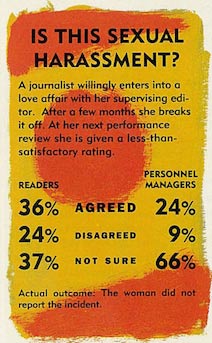 The response was immediate, passionate and overwhelming. Less than a week after the February issue of WORKING WOMAN reached homes and newsstands, thousands of surveys flooded our offices. They came from as far away as Paris and as close as an office building on the next block. Many were accompanied by pages of letters that detailed painful personal experiences. In some workplaces the survey was photocopied and circulated, the results sent back in batches. A man who had been sexually harassed by his female boss wrote that co-workers insisted he fill out the survey. Less than a month after the magazine hit the newsstand, we had received more than 9,000 responses—and they kept coming.
The response was immediate, passionate and overwhelming. Less than a week after the February issue of WORKING WOMAN reached homes and newsstands, thousands of surveys flooded our offices. They came from as far away as Paris and as close as an office building on the next block. Many were accompanied by pages of letters that detailed painful personal experiences. In some workplaces the survey was photocopied and circulated, the results sent back in batches. A man who had been sexually harassed by his female boss wrote that co-workers insisted he fill out the survey. Less than a month after the magazine hit the newsstand, we had received more than 9,000 responses—and they kept coming.
Clearly, the confrontation between Anita Hill and Clarence Thomas had an impact on how and why readers answered. It also had an effect on the human resources executives of the Fortune 500 (the 1,000 companies that make up the top 500 service and 500 industrial corporations). We sent them a simultaneous survey following up a pioneering report “Sexual Harassment in the Fortune 500,” done by this magazine in 1988. This time their responses were somewhat more critical of their companies’ efforts to stop sexual harassment, but, as before, they concluded that the system generally works. Many WORKING WOMAN readers, on the other hand, insist that filing a complaint still amounts to “career suicide.” What’s more, they are angry enough about the spectacle of the Thomas hearings to vote their minds in a year when it matters.
In this, the first major survey to scrutinize and compare the views of these two groups, several messages came through loud and clear:
• Women know what harassment is, either by legal definition (54%) or intuition (30%). Only 15 percent were not sure about the boundaries between harassment and harmless fooling around. The 106 human-resources executives who responded go even further than most readers in toeing the party line, but there’s often a discrepancy between what they say is wrong and how they respond to a real situation.
• The higher a woman is in the corporate hierarchy, the more likely she is to be harassed. More than 60 percent of our readers said they personally have been harassed, and more than a third know a co-worker who has been harassed. However, since only one out of four women reported the harassment and most companies receive fewer than five complaints a month, it’s obvious that the vast majority of women who are harassed don’t feel they can safely report a problem.
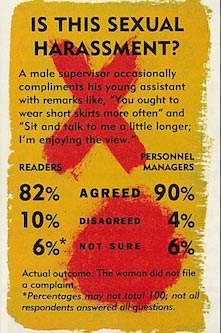 • Women are not at fault. Provocative dressing and behavior or oversensitivity to sexual jokes is not the cause of sexual harassment, say three out of four readers and most of the personnel officers. And over half of the human resources executives also say that office romances that go sour are not the source of many complaints.
• Women are not at fault. Provocative dressing and behavior or oversensitivity to sexual jokes is not the cause of sexual harassment, say three out of four readers and most of the personnel officers. And over half of the human resources executives also say that office romances that go sour are not the source of many complaints.
• It is an issue that matters. Seventy-five percent of readers feel sexual harassment is an issue on a par with salary inequities, inadequate child care and prejudice against promoting women. And more than 90 percent think their companies and the government can-and must-do more to prevent and stop abuse. Only one out of five women believes that most complaints are given justice, but more than 70 percent of the personnel managers think they are.
• Anita Hill changed the picture. Part of the clarity about this issue must be credited to the national teach-in on sexual harassment during the confirmation hearings for Clarence Thomas last fall [see box]. Fifty-nine percent of readers believe that Anita Hill was telling the truth (compared with only 38 percent of the corporate executives), and more than half the readers and third of the personnel managers plan to vote against their senator if he or she voted to confirm Thomas.
Certainly, the hearings provoked discussion in the workplace. While 37 percent of readers said it was treated as a big joke, almost 40 percent said the confrontation brought the issue out in the open and led women to trade war stories about sexual harassment. Here’s what they said.
WHO GETS HARASSED?
The old prey on the young, and the powerful on the less powerful. A female subordinate under 34 being harassed by a male over 35 is the most common scenario, according to both readers and human-resources executives. Almost 30 percent of the incidents occur when the women are 18 to 24 years old-a very large number, considering the small size of this age group in the workforce. In 83 percent of the cases, the harasser is in a more powerful position than the harassed. ” [As] the youngest and newest nurse in the department, I was eager to please,” writes a reader in Hawaii who was harassed by her supervising doctor. “At first [his] remarks were mildly flirtatious. Later he began to be more bold. The one time I was ever alone with him, he grabbed me and kissed me. The last straw was when he, I and another nurse were in our lab. He casually asked how old I was and [said], ‘I wouldn’t want to f—you because it would be like f—ing one of my daughters.”‘
Harassment becomes much more common when women enter some predominantly male workplaces or breach the formerly all-male domain of upper management. “The higher up you climb, the worse the harassment gets,” writes an insurance-company executive from Iowa. “Men feel threatened and choose this behavior to deter our advancement.” Women in managerial and professional positions and earning over $50,000, as well as those working in male-dominated companies, are more likely to experience harassment.
That’s probably why WORKING WOMAN readers reported higher rates of harassment (60%) than respondents to other surveys, whose rates hover between 25 and 40 percent. Lynn Hecht Schafran of the National Organization for Women’s Legal Defense and Education Fund says the WORKING WOMAN figures are “not out of line with what we see in surveys of professional women.”
Recent polls of female chemical engineers, lawyers and executives also found that roughly 6 out of 10 women report harassment. “[I have been] patted, poked and squeezed to death at industry meetings,” writes a marketing executive who worked for a Fortune 500 chemical company. “When I was in sales, I was one of only two females in a division of 22. At regional meetings, the guys always went to strip joints. I [went] back to my room.”
The incidents that reach the attention of corporate officers are often severe, and the profile today is even worse than the one reported by Fortune 500 executives in 1988. Pressure for dates and/or sexual favors occurred in 50 percent of the cases reported to company executives this year but in only 29 percent of the cases in the 1988 survey. In 1992 over 34 percent of the reported incidents involved touching or cornering, compared with 26 percent in 1988. And most of today’s complaints are valid, according to 68 percent of the executives surveyed-4 percent more than agreed with that statement in 1988.
WHY DO MEN DO IT?
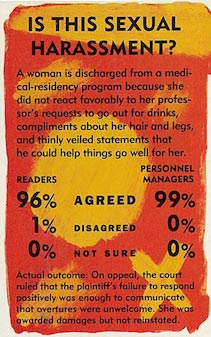 It’s not flirtatiousness, hormones or sexual desire, say many readers. The desire to bully and humiliate women is behind most harassment, according to one out of two readers. “The harasser wants a victim, not a playmate, and a woman with modest dress, makeup and comportment are just as likely-maybe even more likely-to be harassed,” writes a Washington professor.
It’s not flirtatiousness, hormones or sexual desire, say many readers. The desire to bully and humiliate women is behind most harassment, according to one out of two readers. “The harasser wants a victim, not a playmate, and a woman with modest dress, makeup and comportment are just as likely-maybe even more likely-to be harassed,” writes a Washington professor.
A relative few may be responsible for a hefty percentage of harassment cases. Forty-seven percent of the readers who have been harassed have known “chronic harassers,” men who bully one woman after another at work. “Most [harassers] share a common goal-intimidation,” writes a 29-year-old secretary from Pennsylvania. “If someone is capable of harassing a co-worker or subordinate, they’re also likely to take advantage of people in other ways.” Her insight is confirmed by Freada Klein, who conducts training sessions on the problem for major corporations. “We’ve found that workplaces with high rates of sexual harassment also have high rates of racial harassment, discrimination, and other forms of unfair treatment.”
IF IT HAPPENS TO YOU
When asked what they would advise a close friend or relative to do if she were being sexually harassed at work, 79 percent of readers took an assertive stand: “Let the perpetrator know, loud and clear, that if the behavior doesn’t stop, she will turn him in,” one respondent replied. But their advice is often a case of “Do as I say, not as I do.” Among those who themselves have been harassed, only 40 percent told the harasser to stop, and just 26 percent reported the harassment.
Women are not unaware of the contradiction. Though a public-relations director from Houston advises others to fight back, she admits, “I cannot say absolutely that I would file charges, because I need that job! And that fact makes me really angry.”
Trying to ignore the problem was the most common tactic (46%). “A disapproving look or turning away is an almost pitiful strategy for a woman to sympathize.” In fact, a firm “No” can work better than ignoring the problem. One out of three women who protested got the harasser to stop, compared with one out of four who tried to ignore or avoid the harasser.
Dr. Rita R. Newman, a psychiatrist and former president of the American Medical Women’s Association, advises women to document harassment-in dated, written notes or on cassette or videotape even if they don’t intend to report it. If the situation later escalates and you’re forced to take action, you have contemporaneous documentation, which is looked on quite favorably by the law. Even if you never report the incident, Newman says, gaining some control over the situation through documentation can help preserve self-esteem.
CALCULATING THE DAMAGE
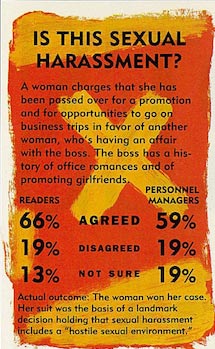 Sexual harassment clearly does hurt women, whether or not they go through the often grueling process of filing a complaint. Readers who were harassed reported such ill effects as being fired or forced to quit their jobs (25%), seriously undermined self-confidence (27%), impaired health (12%) and long-term career damage (13%). Only 17 percent reported no ill effects.
Sexual harassment clearly does hurt women, whether or not they go through the often grueling process of filing a complaint. Readers who were harassed reported such ill effects as being fired or forced to quit their jobs (25%), seriously undermined self-confidence (27%), impaired health (12%) and long-term career damage (13%). Only 17 percent reported no ill effects.
Health problems associated with harassment are similar to those that spring from other stressful situations, such as headache, chronic fatigue, nausea, sleep and appetite disturbances and more frequent colds and urinary-tract infections, says Dr. Diane K. Shrier, professor of clinical psychiatry and pediatrics at New Jersey Medical School at Newark. “Often women and their doctors don’t recognize any links between these symptoms and harassment. And yet, when you take a careful history, you’ll see that the symptoms began as harassment occurred and begin to go away once the situation is resolved.”
Emotional turmoil, which usually affects work performance, is also common. “Women may feel that unless they go along with the harasser, they will face the end of their professional lives,” says Newman. “So they feel exploited, cheapened and forced to submit. For some, self-esteem is impaired forever.”
Forced career detours also take their toll on women’s earning power. “I lost or was forced out of my job each time, while my respective harassers are busily laying, tormenting, embarrassing or firing people as we speak,” wrote a former personnel coordinator from Illinois who was harassed on three different jobs over a long career. The harassed may be doubly victimized by being blamed for the results of their harassment. Many readers who complained were told to take a course in “how to deal with difficult people” or given poor marks on their next reviews.
THE ODDS OF GETTING EVEN
If a woman does decide to fight back and report harassment, what are her chances of getting justice? That depends quite a bit on whom you ask. Those who write company policies are much more bullish about how well they work than those who must use them. Only 21 percent of readers agree that complaints are dealt with justly, and over 60 percent say charges are completely ignored, or offenders are given only token reprimands. Fifty-five percent who have tried reporting harassment found that nothing happened to the harasser. “For 19 years I have been in the Air Force,” writes an information-systems manager. “I have been humiliated by everything from males throwing me up against a wall, running hands up my skirt and grabbing my breasts to sexist jokes and nude pictures plastered over my work station. A year ago a major [showed up at] my house at 10:30 PM. (Fortunately, both of my sons are over six feet.) At work [the major] was always humiliating me by ordering me to straddle the arms of a chair in my skirt and by . rubbing his hands up and down my back and sides. [When I complained], I was threatened to stop pursuing my EOT/EEO complaint, ‘or else.’ I was told that because the major outranked me, his word carried more truth than mine.”
The executives responsible for hearing complaints believe a just resolution is much more common; over 80 percent say most offenders in their companies are punished justly. But that number is down from the1988 survey; then 90 percent of the executives believed offenders were justly punished.
“this is the key contradiction in sexual harassment in the 1990s,” says Freada Klein, who analyzed WORKING WOMAN’S 1988 survey. “In every workplace, we’ve surveyed, we find that a majority of employees don’t have faith in corporate channels for complaint.”
Today 81 percent of Fortune 500 companies report having training programs on sexual harassment compared with only 60 percent in the 1988 survey —although only half of WORKING WOMAN readers work for a company with these procedures.
Most Fortune 500 executives believe their own companies are doing a good job in this area. Even if they are, women believe government must help bring about real change. Most think it should ease (78%) and speed up (80%) the complaint-resolution process, increase the 6-10-month (depending on the state) statue of limitations for reporting abuses (60%) and increase penalties for companies (66%).
THE ULTIMATE INFLUENCE
More and more, the power of the purse will promote change. Interestingly, Fortune 500 executives see their companies as much more legally vulnerable than do readers. The 1991 Civil Rights Act gives harassment victims the right to a jury trail and compensatory and punitive damages for financial and emotional harm, with awards based on company size. Congress is expected to pass an amendment that would lift the current cap ($300,000) on these awards, but companies fear that even with limits, sexual-harassment suits will become the “next asbestos.” it may cost Corporate American more than $1 billion over the next five years to settle these lawsuits, according to calculations by Treasury, a magazine for financial executives. Many companies may begin to push the burden onto the harassers—by firing them promptly.
Even in that legendary lair of harassment, the construction site, fear of monetary loss can bring about change. A female architect, 39, from Chicago reports that one contractor deals with complaints against harassers by immediate dismissal, no reassignment, no second chance. Walking through the job site is like walking through an altar boy’s convention. The color green is the most powerful motivation in this country.”
Behavior can turn around quickly in a workplace once the stakes are raised high enough. “Economic and legal pressures may not immediately change attitudes—that can take decades—but they can change behavior,” notes Helen Neuborne, executive director of the NOW legal Defense and Education Fund. And changing behavior is good enough.
Ronni Sandroff won a Page One Award for her 1988 story “Sexual Harassment in the Fortune 500,’ in WORKING WOMAN.






 The response was immediate, passionate and overwhelming. Less than a week after the February issue of WORKING WOMAN reached homes and newsstands, thousands of surveys flooded our offices. They came from as far away as Paris and as close as an office building on the next block. Many were accompanied by pages of letters that detailed painful personal experiences. In some workplaces the survey was photocopied and circulated, the results sent back in batches. A man who had been sexually harassed by his female boss wrote that co-workers insisted he fill out the survey. Less than a month after the magazine hit the newsstand, we had received more than 9,000 responses—and they kept coming.
The response was immediate, passionate and overwhelming. Less than a week after the February issue of WORKING WOMAN reached homes and newsstands, thousands of surveys flooded our offices. They came from as far away as Paris and as close as an office building on the next block. Many were accompanied by pages of letters that detailed painful personal experiences. In some workplaces the survey was photocopied and circulated, the results sent back in batches. A man who had been sexually harassed by his female boss wrote that co-workers insisted he fill out the survey. Less than a month after the magazine hit the newsstand, we had received more than 9,000 responses—and they kept coming. • Women are not at fault. Provocative dressing and behavior or oversensitivity to sexual jokes is not the cause of sexual harassment, say three out of four readers and most of the personnel officers. And over half of the human resources executives also say that office romances that go sour are not the source of many complaints.
• Women are not at fault. Provocative dressing and behavior or oversensitivity to sexual jokes is not the cause of sexual harassment, say three out of four readers and most of the personnel officers. And over half of the human resources executives also say that office romances that go sour are not the source of many complaints.  It’s not flirtatiousness, hormones or sexual desire, say many readers. The desire to bully and humiliate women is behind most harassment, according to one out of two readers. “The harasser wants a victim, not a playmate, and a woman with modest dress, makeup and comportment are just as likely-maybe even more likely-to be harassed,” writes a Washington professor.
It’s not flirtatiousness, hormones or sexual desire, say many readers. The desire to bully and humiliate women is behind most harassment, according to one out of two readers. “The harasser wants a victim, not a playmate, and a woman with modest dress, makeup and comportment are just as likely-maybe even more likely-to be harassed,” writes a Washington professor.  Sexual harassment clearly does hurt women, whether or not they go through the often grueling process of filing a complaint. Readers who were harassed reported such ill effects as being fired or forced to quit their jobs (25%), seriously undermined self-confidence (27%), impaired health (12%) and long-term career damage (13%). Only 17 percent reported no ill effects.
Sexual harassment clearly does hurt women, whether or not they go through the often grueling process of filing a complaint. Readers who were harassed reported such ill effects as being fired or forced to quit their jobs (25%), seriously undermined self-confidence (27%), impaired health (12%) and long-term career damage (13%). Only 17 percent reported no ill effects.